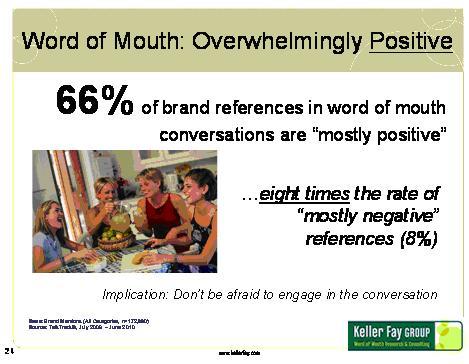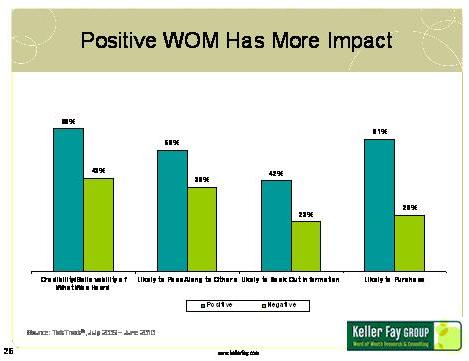Two-Thirds of all Brand Related Word-of-Mouth is Positive - Ed Keller - MediaBizBloggers

By now most marketers recognize the central role that word of mouth and social media play in consumer decision making and strategies to tap the power of word of mouth – both online via social media channels and offline – is becoming a more important priority.
However, there remains a lingering concern for many marketers. How can they be certain that they won't say negative things if they facilitate consumer conversation? And isn't the power of negative WOM far greater than positive?
The first question – "how can we be certain that consumers won't say negative things about us?" – demands two answers. The first answer is that as marketers, we can't be certain that consumers will always have nice things to say. There is clearly less control on the part of marketers when the consumer voices rise to the top of your marketing strategy. When compared to the certainty that comes from a message that the marketer crafts, and places, WOM is a scary thing. But as McKinsey reminded us recently, "The rewards of pursuing excellence in word-of-mouth are huge, and it can deliver a significant competitive edge few other marketing approaches can match."
The second answer should be more comforting. The overwhelming amount of brand-related word of mouth is positive, not negative. According to Keller Fay research, two-thirds of all brand-related conversations are positive toward the brand; less than ten percent of the time is it negative. (The rest is either "mixed" or "neutral.")
This is an aggregate across hundreds of thousands of conversations that we measure each year about every different type of brand. Some are more positive than the average; others are more negative than the average. Categories that skew well above average in terms of positive word of mouth include children's products, personal care products, food/dining, and beverages. Categories that are above average in terms of negative word of mouth include telecommunications, financial services, and health care. But even in these lower scoring categories, the preponderance of word of mouth remains positive.
A very similar picture emerges when one looks at word of mouth through a different prism – the average ratings for brands on rating and review sites. According to Bazaarvoice, a technology provider that powers rating and review sites for leading retailers and brands, there is a "J-curve" when it comes to consumer reviews. In the US, 80% of product ratings are four or five stars; in the UK, the figure is even higher – 88%. (Disclosure: I am on the Board of Directors of Bazaarvoice.) Yelp finds something quite similar – the volume of positive reviews outweighs the negative by 6:1.
So while it's theoretically possible that consumers could use word of mouth channels to "diss" brands and spout off about negative experiences, this is not in fact what they do most of the time. And why not? Because the "ask" in word of mouth is for advice and recommendations about smart choices. What brands do you recommend would be good choices for me? Nobody approaches someone else and says, "Please tell me about your most recent bad experience." They say, "I am looking to make a car purchase, or looking for a restaurant recommendation, or thinking about where to get the best deals on items I need to buy for my household; what recommendations to you have?"
When presented with "the facts" about the preponderance of positive word of mouth relative to negative, there remains a belief on the part of many that somehow the negative word of mouth carries a lot more weight. This attitude is captured in the title of my friend Pete Blackshaw's 2008 book, "Satisfied Customers Tell Three Friends, Angry Customers Tell 3,000."
But the statistics tell a different story. While there are some high profile instances in which a major gaff by a brand gets spread like wild fire on social media, these are the exceptions and not the rule. Not only is there far, far more positive word of mouth than negative, but our research is clear that positive word of mouth has more impact than negative. There is considerably more credibility/believability when someone hears positive things about a brand rather than negative. Based on tens of thousands of brand conversations studied each year, we find that when they are on the receiving end of advice and recommendations, 66% of consumers attach high levels of credibility to WOM conversations that are positive in nature, versus 43% to those that are negative. Similarly, they are far more likely to pass along what they learn to others when the conversation is positive rather than negative – in other words, the viral nature of positive WOM is greater than when it's negative.
It has been more than a half century since Norman Vincent Peale first popularized the concept, "the power of positive thinking." It is now time for marketers to embrace the power of positive conversation.
Ed Keller, CEO of the Keller Fay Group, has been called "one of the most recognized names in word of mouth." The publication of Keller's book,The Influentials, has been called the "seminal moment in the development of word of mouth." Ed can be contacted at ekeller@kellerfay.com.
Read all Ed’s MediaBizBloggers commentaries at Ed Keller - MediaBizBloggers.
Check us out on Facebook at MediaBizBloggers.com
Follow our Twitter updates @MediaBizBlogger




